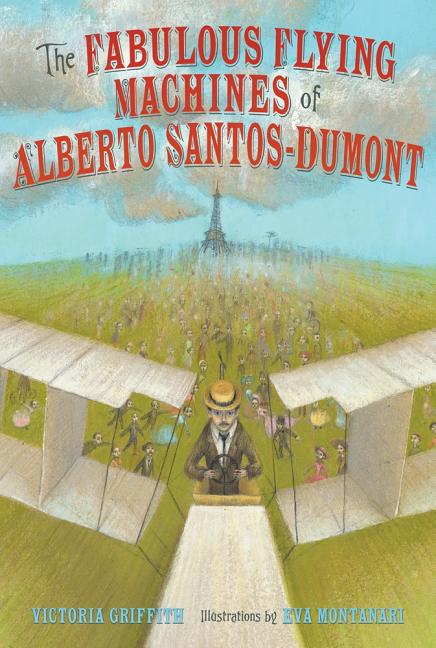Book Descriptions
for The Fabulous Flying Machines of Alberto Santos-Dumont by Victoria Griffith and Eva Montanari
From Cooperative Children's Book Center (CCBC)
From the Publisher
While the Wright Brothers were gliding over Kitty Hawk, the charming Brazilian Alberto Santos-Dumont was making his own mark on the history of flight.
Alberto loved floating over Paris in his personal flying machine called a dirigible. He would tie it to a post, climb down, and spend the day shopping or meeting friends for coffee. But he wanted to make his invention even better. By 1906, Alberto had transformed his balloon into a box with wings! But now there was competition. Another inventor challenged Alberto to see who would be the first in flight. Alberto's hard work paid off, and his airplane successfully soared into the air, making him the first pilot to lift off and land a completely self-propelled plane.
The book includes an author's note about Santos-Dumont, a bibliography, an index, and photographs of his flying machines.
Praise for Fabulous Flying Machines of Alberto Santos-Dumont
"At the turn of the last century, all sorts of ambitious and eccentric men were competing furiously to get the first airplane into the sky. One of the most famous of these was a dashing Brazilian who lived in Paris and, to wide admiration, did his errands by airship. Victoria Griffith tells his story...which is illustrated with panache in rich, smudgy oils and pastels by Italian artist Eva Montanari." -Wall Street Journal
"An excellent read-aloud, this picture book is a must when studying the history of flight and can be used as a resource for research, a book for all your reading needs!" -Library Media Connection
"Montanari's chalky illustrations are distinguished by a strong sense of motion, and the story's suspense (rival pilots! harrowing landings!) and surprise cameos (Louis Cartier!) make this an elegant tribute to a hero of early aviation." -Publishers Weekly
"Strong vertical trim and layout, which one would expect to exploit sweeping skyscapes, are instead cleverly deployed to put viewers among the earthbound spectators, most often glimpsing the aviator in the distance. A bibliography and brief index round out the title, which will be a first choice for aviation enthusiasts." -The Bulletin of the Center for Children's Books
"A generous spirit and penchant for grand gestures make him [Santos-Dumont] all the more worth knowing--particularly for American audiences unaware that there is any question about who was the first to fly. -Kirkus Reviews
"Montanari captures the look, dress, and formality of the era in her splendid, impressionistic pastel, chalk, and oil paintings. The endnotes add details and facts about the life of this charismatic, adventurous man and mark his place in aviation history." -School Library Journal
"Even if you've never heard of Santos-Dumont, you'll be delighted to meet this real-life historical figure in Victoria Griffith's vivid debut picture book. This fine picture book resurrects his story in lively prose and large-scale illustrations rendered in pastels, chalks, oil pastels and oil paint, perfectly capturing the drama of the events. The fuzzy lines lend a feeling of history to the illustrations, and gestures and humorous touches, such as a dog holding the dirigible's tether or Alberto racing horse-drawn carriages, make Alberto Santos-Dumont and his times come alive." -BookPage

